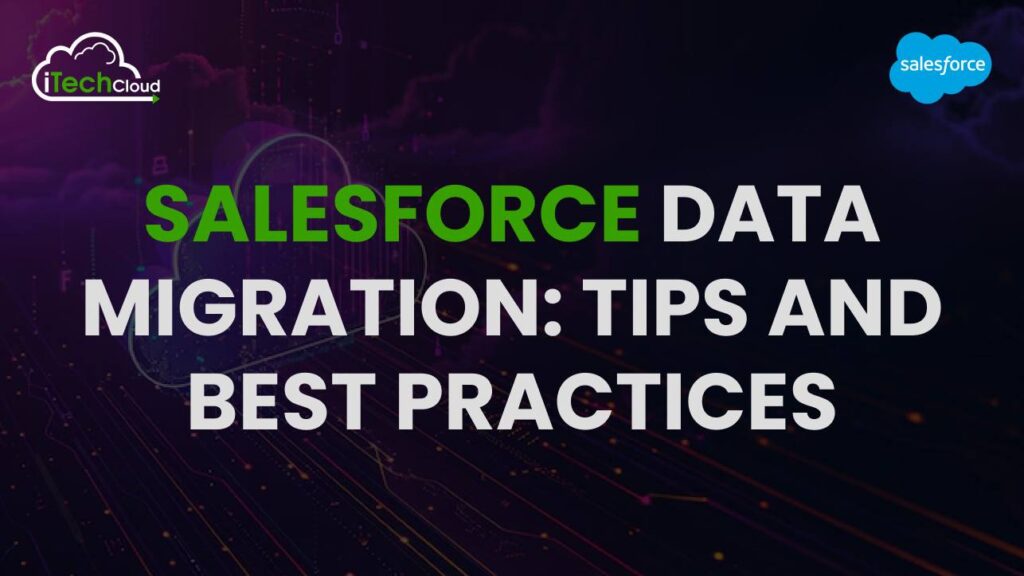Salesforce Data Migration Best Practices

Salesforce Data migration is a critical process in any Salesforce implementation or upgrade project. It involves transferring data from one system to another, ensuring data integrity, accuracy, and usability. Whether you are moving data from a legacy system to Salesforce, consolidating multiple Salesforce orgs, or upgrading to Salesforce’s latest features, a well-planned data migration strategy is essential for success. In this guide, we will explore the key aspects of Salesforce data migration, best practices, and tools to ensure a seamless transition.
Table of Contents
What is Salesforce Data Migration?
Salesforce Data Migration is the process of transferring data into Salesforce or between Salesforce instances. It involves extracting data from a source system, transforming it to fit Salesforce’s format, and loading it into the platform. This ensures data accuracy, consistency, and integrity during system transitions, upgrades, or integrations, enabling businesses to maintain seamless operations in Salesforce.
Why is Salesforce Data Migration Important?
Data migration is crucial for organizations as it ensures the seamless transfer of essential data, maintaining business continuity and operational efficiency. In the context of Salesforce implementation or upgrades, effective data migration plays a vital role in various aspects of business operations.
1. Continuity:
One of the primary reasons for data migration is ensuring that there is no disruption in business processes. When transitioning to Salesforce, it is essential to maintain access to the data that drives day-to-day operations. A smooth migration ensures that workflows are not interrupted, allowing businesses to continue functioning as usual.
2. Data Integrity:
Accuracy and consistency are critical when handling business data. Data migration ensures that the data being transferred into Salesforce retains its integrity. It eliminates errors, inconsistencies, and redundancies, ensuring the new system contains high-quality, reliable data that supports decision-making and analytics.
3. Improved User Adoption:
Clean, organized data encourages users to adopt Salesforce effectively. If users encounter cluttered or incomplete data, it can lead to frustration and a reluctance to use the platform. Proper data migration ensures the system is populated with structured, relevant information, improving user experience and engagement.
4. Compliance:
Organizations must adhere to regulatory requirements governing data handling, such as GDPR, HIPAA, or other industry-specific standards. Data migration ensures that these requirements are met by accurately transferring data while maintaining security and privacy standards. Proper migration prevents potential legal or compliance issues related to data storage and handling.
Key Challenges in Salesforce Data Migration
Salesforce data migration is a critical process, but it comes with several challenges that organizations must overcome to ensure successful implementation and data integrity.
Some of the key challenges include:
1. Data Quality and Accuracy:
One of the most common issues faced during migration is ensuring the accuracy and quality of the data. Data from legacy systems may be incomplete, outdated, or contain errors, which can affect the integrity of the migrated data. Identifying and cleaning data before migration is essential, but this process can be time-consuming and complex, especially for large datasets.
2. Data Mapping and Transformation:
Salesforce uses specific data structures, and aligning the data from source systems to these structures can be difficult. Mapping data fields between the old system and Salesforce requires a detailed understanding of both systems. Moreover, the data may need to be transformed to fit Salesforce’s requirements, such as converting formats or restructuring relationships, which can be complicated and error-prone.
3. Data Loss and Corruption:
During migration, there is always a risk of data loss or corruption, especially if proper backup procedures aren’t followed. This can happen due to issues with the migration tool, connectivity problems, or incorrect transformations. Ensuring data is thoroughly backed up before migration, as well as running tests, can help mitigate this risk.
4. Complexity of Legacy Systems:
Migrating data from older or custom-built systems can be especially challenging. These systems may not have standardized data formats, making it difficult to extract clean, usable data. Legacy systems often lack integration capabilities, requiring custom solutions or middleware to bridge the gap with Salesforce.
5. Integration with Third-Party Systems:
Many organizations rely on third-party applications that integrate with Salesforce. Ensuring seamless integration during migration is complex, especially when different systems use different data formats or communication protocols. Integration testing is critical to avoid disruptions in business processes that rely on these integrations.
6. Downtime and Business Disruption:
Migrating large datasets can lead to system downtime or business disruption if not planned carefully. It’s essential to plan migrations during low-traffic periods or implement gradual migrations to minimize the impact on daily operations.
7. User Adoption:
After the migration, employees must adapt to the new system. If the migration leads to data inconsistencies or confusion, user adoption can be hindered, reducing the effectiveness of the Salesforce platform. Ensuring that data is clean and organized, and providing adequate training, is key to overcoming this challenge.
Steps for Successful Salesforce Data Migration
Successful Salesforce data migration involves several critical steps to ensure data integrity, minimize disruption, and optimize the platform’s use.
Below are the key steps for a successful migration:
1. Define the Migration Scope:
The first step is to clearly define the scope of the migration. This includes understanding what data needs to be migrated, whether it’s accounts, contacts, opportunities, or custom objects. The scope also involves identifying any third-party systems to be integrated and setting clear goals for what the migration should achieve.
2. Assess and Clean Data:
Data quality is crucial for a successful migration. Before migration, it’s essential to assess the data from the source systems for accuracy, completeness, and consistency. This step involves identifying and cleaning duplicates, correcting errors, and ensuring the data is up-to-date. A thorough data cleansing process minimizes the risk of transferring incorrect or incomplete data into Salesforce.
3. Create a Data Mapping Plan:
Salesforce has specific data structures, and aligning your existing data with these structures requires careful mapping. In this step, data fields from the source system are mapped to Salesforce fields, ensuring proper alignment. This may involve transforming data formats or restructuring relationships between records to match Salesforce’s requirements.
4. Select the Right Migration Tool:
Choosing the right tool for migration is essential. There are several data migration tools available, such as Salesforce Data Loader, third-party ETL tools, and custom-built solutions. The selected tool should support the volume of data being migrated, provide error logging, and offer features like data validation and transformation.
5. Test the Migration Process:
Before performing the full migration, it’s critical to conduct a test migration with a small dataset. This test helps identify potential issues with data mapping, transformation, and the tool itself. Running tests ensures that data will migrate smoothly without errors and that the Salesforce environment is properly configured.
6. Perform the Migration:
Once testing is successful, the actual migration can begin. It’s essential to follow a structured approach and ensure all data is transferred accurately. Depending on the volume of data, the migration may be performed in stages to minimize downtime and business disruption.
7. Validate and Verify Data:
After migration, it’s important to validate the data in Salesforce. This involves checking for any discrepancies, ensuring that all records are correctly populated, and confirming that relationships between objects are intact. Validation should also include verifying data integrity and confirming that key business processes are functioning as expected.
8. Provide User Training and Support:
Once data is migrated, ensure that users are trained on how to navigate and use Salesforce with the new data. Proper user training enhances adoption and ensures that the organization can fully leverage the Salesforce platform. Offering ongoing support helps users address issues as they arise.
9. Monitor and Optimize:
After the migration, continuous monitoring is important to ensure that the data is being used effectively and that no issues have been overlooked. Regular optimization of data processes, integrations, and system configurations ensures long-term success.
Salesforce Data Migration Tools
Several tools can simplify and enhance the Salesforce data migration process, depending on the complexity and size of the data:
1. Salesforce Data Loader:
A free, Salesforce-provided tool that is widely used for importing, exporting, updating, and deleting data. It is suitable for medium to large datasets and provides an easy-to-use interface. While it is powerful, it requires some familiarity with CSV files and basic data manipulation. It’s ideal for standard migration tasks but may not be as effective for very large or complex migrations.
2. Salesforce Workbench:
A web-based suite offering more advanced capabilities, including querying, updating, and performing administrative tasks in Salesforce. It is especially useful for users who are comfortable with Salesforce Object Query Language (SOQL) and require more granular control over their data. Workbench is suited for more technical users or those with specific customization needs but can be more challenging for beginners.
3. Third-Party ETL Tools:
Tools like Informatica, MuleSoft, and Talend are designed for more complex migrations, often in large enterprises with intricate data requirements. These ETL (Extract, Transform, Load) tools provide robust features for mapping, transforming, and migrating large volumes of data across multiple systems. They offer scalability, automation, and advanced data transformation capabilities, making them ideal for sophisticated and high-volume migration projects.
4. Custom Scripts and APIs:
For organizations with very specific or unique data migration needs, developers can use Salesforce APIs (like the REST API or Bulk API) to create custom scripts. This provides the flexibility to tailor the migration process to particular requirements, such as complex data transformations or integration with other systems. This method requires technical expertise but can offer the most customization.
5. AppExchange Solutions:
Salesforce’s marketplace offers pre-built solutions specifically designed for different migration scenarios. These solutions can address unique data migration needs, such as moving data from legacy systems or integrating with third-party platforms. They are convenient for businesses looking for specialized tools without building custom scripts or integrations.
Best Practices for Salesforce Data Migration
1. Start with a Clear Plan:
Define the scope, timelines, and responsibilities for the migration project from the outset. Align the strategy with business objectives to ensure the migration supports broader organizational goals, providing clarity and direction throughout the process.
2. Prioritize Data Quality:
Conduct thorough data cleansing and validation before migration to ensure only accurate and relevant information is moved to Salesforce. Establish a single source of truth for critical records to prevent discrepancies and maintain consistency across systems.
3. Involve Stakeholders:
Actively involve business users, IT teams, and data owners throughout the migration. Their input is crucial for identifying key data and ensuring it meets business needs. Regular communication ensures that concerns are addressed promptly and keeps all stakeholders aligned.
4. Focus on Security:
Protect sensitive data during the migration by using secure channels for data transfer. Adhere to compliance standards such as GDPR or HIPAA to safeguard against legal or regulatory risks, ensuring that data privacy and security are maintained.
5. Test Extensively:
Testing in sandbox environments is vital to identify potential issues early. Conduct thorough tests, including edge cases and exceptions, to ensure that the migrated data functions as expected. This proactive approach helps minimize errors during the full migration.
6. Document Everything:
Maintain comprehensive records of data mappings, transformations, and validation rules throughout the migration process. Documenting lessons learned and challenges faced is valuable for future migrations, enabling continuous improvement and smoother transitions.
Conclusion:
Salesforce data migration is a critical process for ensuring seamless transitions during implementation, upgrades, or integrations. Success relies on thorough planning, prioritizing data quality, stakeholder involvement, and robust security measures. Testing extensively in sandbox environments and documenting every step ensures accuracy and prepares for future migrations.
By leveraging appropriate tools and adhering to best practices, organizations can transfer data efficiently while maintaining its integrity and compliance. A well-executed data migration supports business continuity, enhances user adoption, and unlocks the full potential of Salesforce, enabling businesses to operate effectively and make data-driven decisions.

